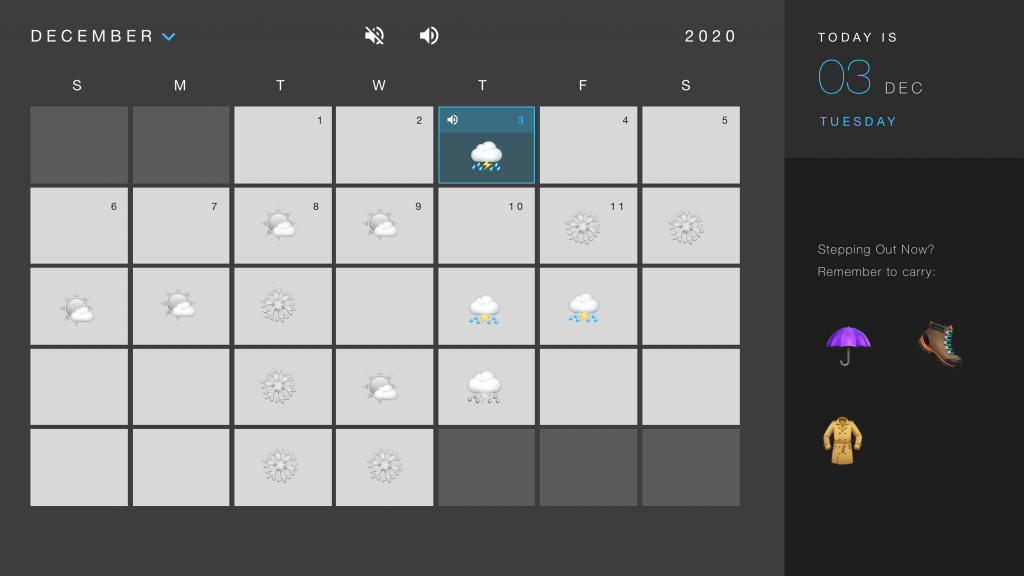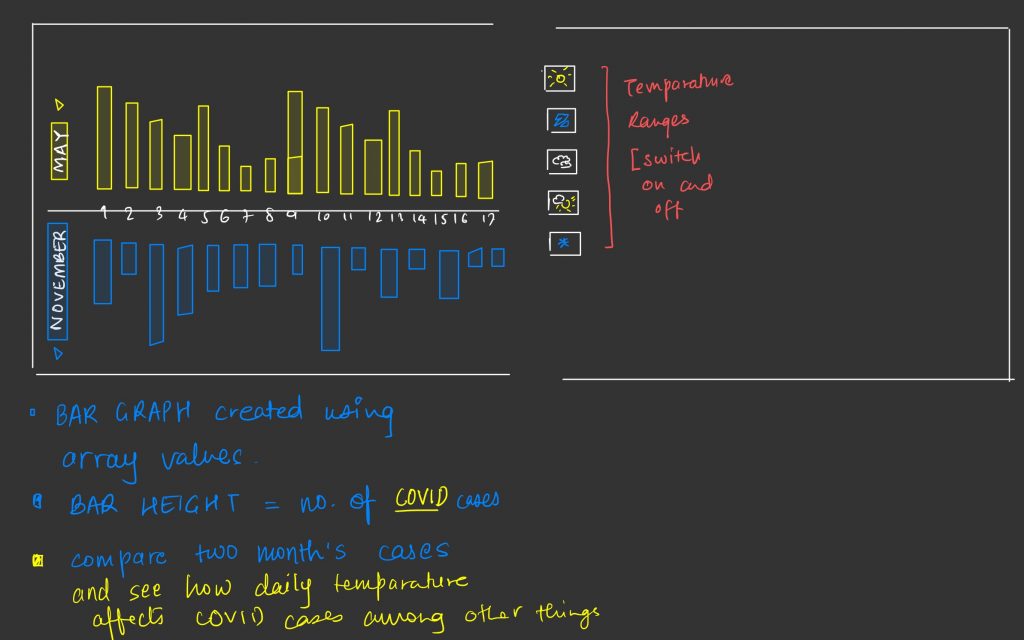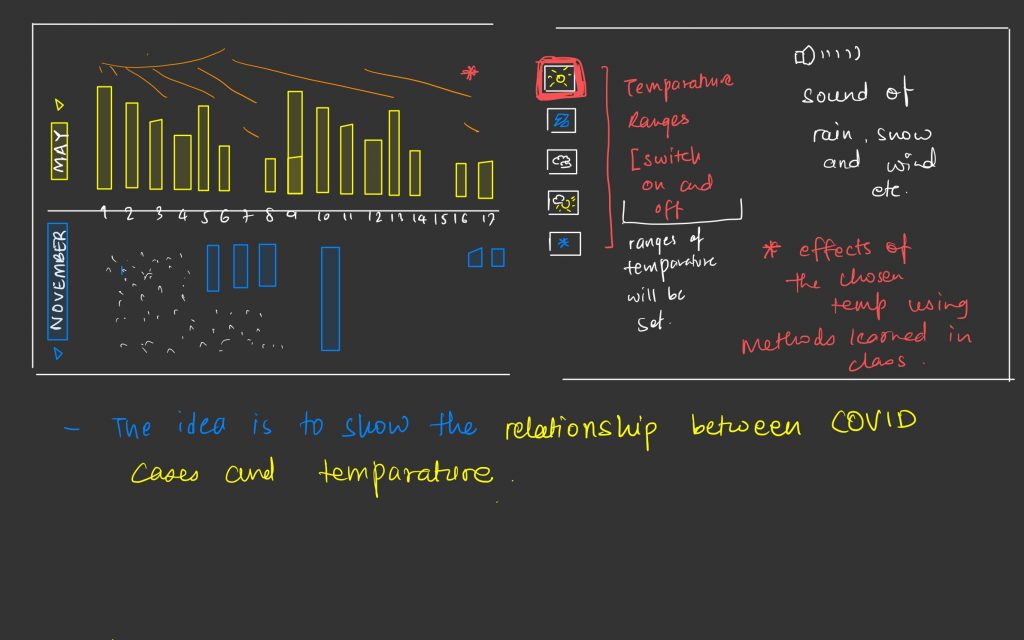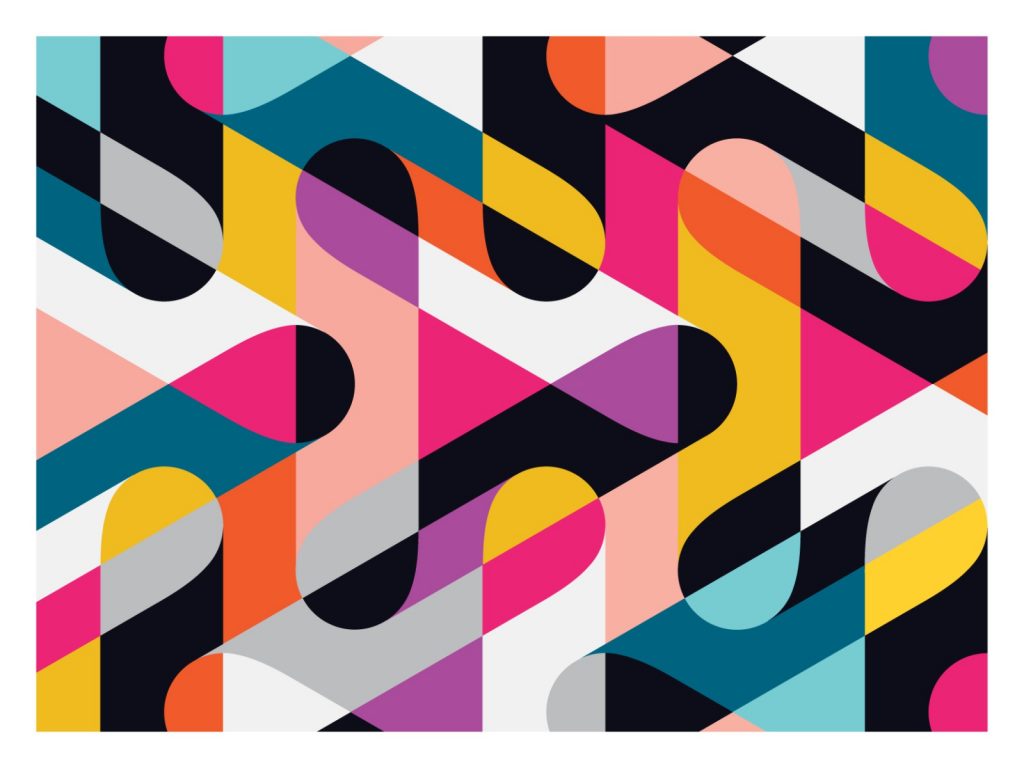https://editor.p5js.org/ssahasra/present/mf6vOSPgw
The idea was to correlate temparatures and COVID cases of two months far apart from each other in the year 2020.
I used arrays to fill in the values of the number of cases (height of bar) with loops and used the buttons [mouse interactions] and array, objects to create effects of different weather conditions. For some of the weather effects I sourced code from current projects on the internet.

After receiving feedback on my proposal, I made two key changes:
1. Instead of using files to load data I added the values to indices of an array, to create a data visualization + monthly calendar that shows the number of COVID cases
2. I made it more relevant to the theme of 2020. Earlier I was working only with temperature data, but now I decided to represent the relationship between temperature and COVID cases.
The central idea of my projects is to create an interactive visualization + calendar that allows the viewer to compare different months of the year and see how temperature affects the rise in COVID cases (although there are of course other factors for the rise) Furthermore, I want to use mouse interactions to filter certain days when temperatures are in particular range using the buttons on the right (see diagram and code). I am still in the process of adding interactivity and controls using the <function mousePressed()> Optionally, a hover state over one or two of the bars (if time permits, to show the temperature and number of COVID cases to make it a more realistic visualisation)
When the button is pressed, some bar graphs that are not in that temperature range, will disappear and I want to use random motion, I learnt in class to create effects of snow, rain, sun etc in the background of each month. If I am successful in this, as a next step, I would also like to add sound files that create sound effects along with the visual effects of the weather. For the visual effects, my plan is to use the code I used for the snow and change parameters, color, speed etc, to create the other weather effects. For examples: raindrops will be blue and would sway less, and fall down in straighter lines than snow.
Below is the code snippet for the entire final program:
let lastFramePress = false;
let toggle = false;
let value = 0;
let button;
let snowflakes = []; // array to hold snowflake objects
let rain = [];
let snow ;
mayCases = [1540, 1307, 1008, 913, 975, 1022, 1160, 1352, 1160,
1376, 520, 850, 787, 964, 1020, 1050, 517, 931, 728,
747, 1101, 1053, 797, 554, 700, 517, 773, 666, 761, 716, 429]
mayMidTempCases = [0, 1307, 1008, 0, 0, 0, 1160, 0, 0,
1376, 0, 0, 787, 964, 0, 1050, 0, 931, 728,
747, 1101, 1053, 797, 0, 0, 0, 0, 0, 761, 716, 429] //on high temparature days
mayHighTempCases = [0, 0, 0, 0, 0, 0, 0, 0, 0,
0, 0, 0, 0, 0, 1020, 0, 517, 0, 0,
0, 0, 0, 0, 554, 700, 517, 773, 666, 761, 716, 429] //on mid temparature days
mayLowTempCases = [1540, 0, 0, 913, 975, 1022, 0, 1352, 1160,
0, 520, 850, 0, 0, 0, 0, 0, 0, 0,
0, 0, 0, 0, 0, 0, 0, 0, 0, 0, 0, 0] //on low temparature days
novCases = [2815, 3648, 3236, 2580, 4562, 4322, 4098, 6023,
5834, 4395, 4647, 6241, 5721, 6486, 6881, 7028,
5874, 6541, 6462, 6365, 6956, 7427, 8362, 6883,
5144, 5584, 6956, 8654, 11268, 5000]
novHighTempCases = [0, 0, 3236, 2580, 4562, 4322, 0, 0,
0, 0, 0, 0, 0, 0, 0, 0,
0, 0, 0, 0, 0, 0, 0, 0,
0, 0, 0, 0, 0, 0]
novMidTempCases = [2815, 3648, 0, 0, 0, 0, 4098, 6023,
0, 0, 4647, 0, 0, 0, 6881, 7028,
5874, 6541, 0, 0, 0, 7427, 8362, 6883,
0, 5584, 0, 0, 0, 0]
novLowTempCases = [0, 0, 0, 0, 0, 0, 0, 0,
0, 4395, 0, 6241, 5721, 6486, 0, 0,
0, 0, 6462, 0, 6956, 0, 0, 0,
5144, 0, 6956, 8654, 11268, 5000]
function preload() {
cloud = loadImage('https://i.imgur.com/MsvLwqH.png');
snowFlake = loadImage('https://i.imgur.com/wvzYocn.png');
sun = loadImage('https://i.imgur.com/AGRTqDm.png');
}
function setup() {
//star-size
let SWH1 = random(2, 8);
let SWH2 = random(6, 10);
let SWH3 = random(10, 13);
background(51,59,68);
createCanvas(1300, 900);
button = createButton("☀️");
button.mousePressed();
button.position(1180, 90);
button.size(50,50);
button.style('font-size', '25px');
button = createButton("☁️");
button.mousePressed();
button.position(1180, 160);
button.size(50,50);
button.style('font-size', '25px');
button = createButton("❄️");
button.mousePressed();
button.position(1180, 230);
button.size(50,50);
button.style('font-size', '25px');
}
function draw() {
background(51,59,68);
fill(255);
textSize(12);
text ('M A Y : C O V I D C A S E S', 50, 80);
text ('N O V E M B E R : C O V I D C A S E S', 50, 780);
textSize(21);
text ('D o C O V I D C a s e s I n c r e a s e W h e n T e m p ar a t u r e s L o w e r ?', 50, 840, 900, 60);
strokeWeight(3.2);
fill(255,10);
noStroke();
rect(50,80,width-200,320);
rect(50,450,width-200,320);
translate(30,50);
fill(255, 80);
may();
fill(255,0,0,80);
november();
calendar();
//sunrays();
rainfall();
noStroke();
fill(255);
//mayHigh();
mousePressed();
fill(255,10);
rect(1137, 27, 60, 60);
rect(1137, 97, 60, 60);
rect(1137, 167, 60, 60);
}
function calendar() {
fill(51,59,68);
for (let i=0;i<31;i++) {
let index = i + 1;
//stroke(255, 50);
push();
fill(255);
noStroke();
textSize(12);
text(index, i*(245/7)+38, 380);
pop();
}
}
//____////____////____////____////____////____////____////____////____////____////____////____//
function createSnowflake() {
// create a random number of snowflakes each frame
let t = frameCount / 60; // update time
for (let i = 0; i < random(5); i++) {
fill(255);
snowflakes.push(new snowflake()); // append snowflake object
}
// loop through snowflakes with a for..of loop
for (let flake of snowflakes) {
flake.update(t); // update snowflake position
flake.display(); // draw snowflake
}
}
function snowflake() {
//referenced from the p5.js open source examples
// initialize coordinates
this.posX = 0;
this.posY = random(-50, 0);
this.initialangle = random(0, 2 * PI);
this.size = random(2, 5);
// radius of snowflake spiral
// chosen so the snowflakes are uniformly spread out in area
this.radius = sqrt(random(pow(width / 2, 2)));
this.update = function(time) {
// x position follows a circle
let w = 0.6; // angular speed
let angle = w * time + this.initialangle;
this.posX = width / 2 + this.radius * sin(angle);
// different size snowflakes fall at slightly different y speeds
this.posY += pow(this.size, 0.5);
// delete snowflake if past end of screen
if (this.posY > height) {
let index = snowflakes.indexOf(this);
snowflakes.splice(index, 1);
}
};
this.display = function() {
ellipse(this.posX, this.posY, this.size);
}
}
//____////____////____////____////____////____////____////____////____//
function createRain() {
// create a random number of snowflakes each frame
let t = frameCount / 60; // update time
for (let i = 0; i < random(5); i++) {
fill(255);
rain.push(new rainfall()); // append snowflake object
}
// loop through snowflakes with a for..of loop
for (let drop of rain) {
drop.update(t); // update snowflake position
drop.display(); // draw snowflake
}
}
function rainfall() {
this.posX = 10;
this.posY = random(0, width);
this.initialangle = random(0, PI);
this.size = random(4, 20);
// radius of snowflake spiral
// chosen so the snowflakes are uniformly spread out in area
this.radius = sqrt(random(0,1000), 1);
this.update = function(time) {
// x position follows a circle
let w = 1; // angular speed
let angle = w * time + this.initialangle;
this.posX = width / 35 + 1000 * sin(angle); // change this angle for rain
// different size snowflakes fall at slightly different y speeds
this.posY += pow(this.size, 5);
// delete snowflake if past end of screen
if (this.posY > 260) {
let index = rain.indexOf(this);
rain.shift(index, 3);
}
}
this.display = function() {
ellipse(this.posX, this.posY, this.size);
}
}
//____////____////____////____////____////____////____////____////____////____//
function sunrays() {
rays = random(280, 650);
//stars in the universe
fill(250, 200, 0);
ellipse(mouseX*1.1, mouseY*1.8, random(2, 8), random(2, 8));
ellipse(mouseX*1.3, mouseY*2.5, random(6, 10), random(6, 10));
ellipse(mouseX*2.3, mouseY*1.5, random(10, 13), random(10, 13));
ellipse(mouseX/1.1, mouseY/1.8, random(2, 8), random(2, 8));
ellipse(mouseX/1.3, mouseY/2.5, random(6, 10), random(6, 10));
ellipse(mouseX/2.3, mouseY/1.5, random(10, 13), random(10, 13));
//glow
fill(200, 130, 10, 20);
ellipse(0, 0, (frameCount % 500)*2, (frameCount % 500)*2);
ellipse(0, 0, (frameCount % 500)*4, (frameCount % 500)*4);
ellipse(0, 0, (frameCount % 500)*8, (frameCount % 500)*8);
ellipse(0, 0, (frameCount % 500)*16, (frameCount % 500)*16);
ellipse(0, 0, (frameCount % 500)*24, (frameCount % 500)*24);
//sun
fill(250, 200, 0);
ellipse(5, -11, rays - 20, rays - 30);
}
function may() {
for (var i=0; i <= mayCases.length; i++) {
fill(255, 99);
rect((i*35+3)+25,350,33,-mayCases[i]*0.035);
//ellipse((i*35+3)+25,190,-mayCases[i]*0.035);
}
if (mayCases[i]*0.25 >= 20) {
fill(255, 99);
}
}
function mayHigh() {
for (var i=0; i <= mayHighTempCases.length; i++) {
fill(255,99);
rect((i*35+3)+25,350,33,-mayHighTempCases[i]*0.035);
}
if (mayHighTempCases[i]*0.25 >= 20) {
fill(255,0,0,99);
}
}
function mayMid() {
for (var i=0; i <= mayMidTempCases.length; i++) {
fill(255,99);
rect((i*35+3)+25,350,33,-mayMidTempCases[i]*0.035);
}
if (mayMidTempCases[i]*0.25 >= 20) {
fill(255,99);
}
}
function mayLow() {
for (var i=0; i <= mayLowTempCases.length; i++) {
fill(255,99);
rect((i*35+3)+25,350,33,-mayLowTempCases[i]*0.035);
}
if (mayLowTempCases[i]*0.25 >= 20) {
fill(255,0,0,99);
}
}
function november() {
for (var i=0; i <= novCases.length; i++) {
rect((i*35+3)+25,400,33,novCases[i]*0.035);
//ellipse((i*35+3)+25,560,-novCases[i]*0.035);
}
}
function novLow() {
for (var i=0; i <= novLowTempCases.length; i++) {
fill(255,0,0,99);
rect((i*35+3)+25,400,33,novLowTempCases[i]*0.035);
//ellipse((i*35+3)+25,560,-novCases[i]*0.035);
}
if (novLowTempCases[i]*0.25 >= 20) {
fill(255,0,0,99);
}
}
function novMid() {
for (var i=0; i <= novMidTempCases.length; i++) {
fill(255,0,0,99)
rect((i*35+3)+25,400,33,novMidTempCases[i]*0.035);
//ellipse((i*35+3)+25,560,-novCases[i]*0.035);
}
if (novMidTempCases[i]*0.25 >= 20) {
fill(255,0,0,99);
}
}
function novHigh() {
for (var i=0; i <= novHighTempCases.length; i++) {
fill(255,0,0,99);
rect((i*35+3)+25,400,33,novHighTempCases[i]*0.035);
//ellipse((i*35+3)+25,560,-novCases[i]*0.035);
}
if (novHighTempCases[i]*0.25 >= 20) {
fill(255,0,0,99);
}
}
function mousePressed() {
//rect(1137, 27, 60, 60);
//rect(1137, 97, 60, 60);
//rect(1137, 167, 60, 60);
if (mouseX >= 1137 && mouseX <= 1197 && mouseY >= 40 && mouseY <= 110) {
mayHigh();
novHigh();
sunrays();
} else if (mouseX >= 1137 && mouseX <= 1197 && mouseY >= 110 && mouseY <= 180) {
mayMid();
novMid();
createRain();
} else if (mouseX >= 1137 && mouseX <= 1197 && mouseY >= 200 && mouseY <= 250) {
mayLow();
novLow();
createSnowflake();
}
}![[OLD FALL 2020] 15-104 • Introduction to Computing for Creative Practice](../../wp-content/uploads/2021/09/stop-banner.png)




